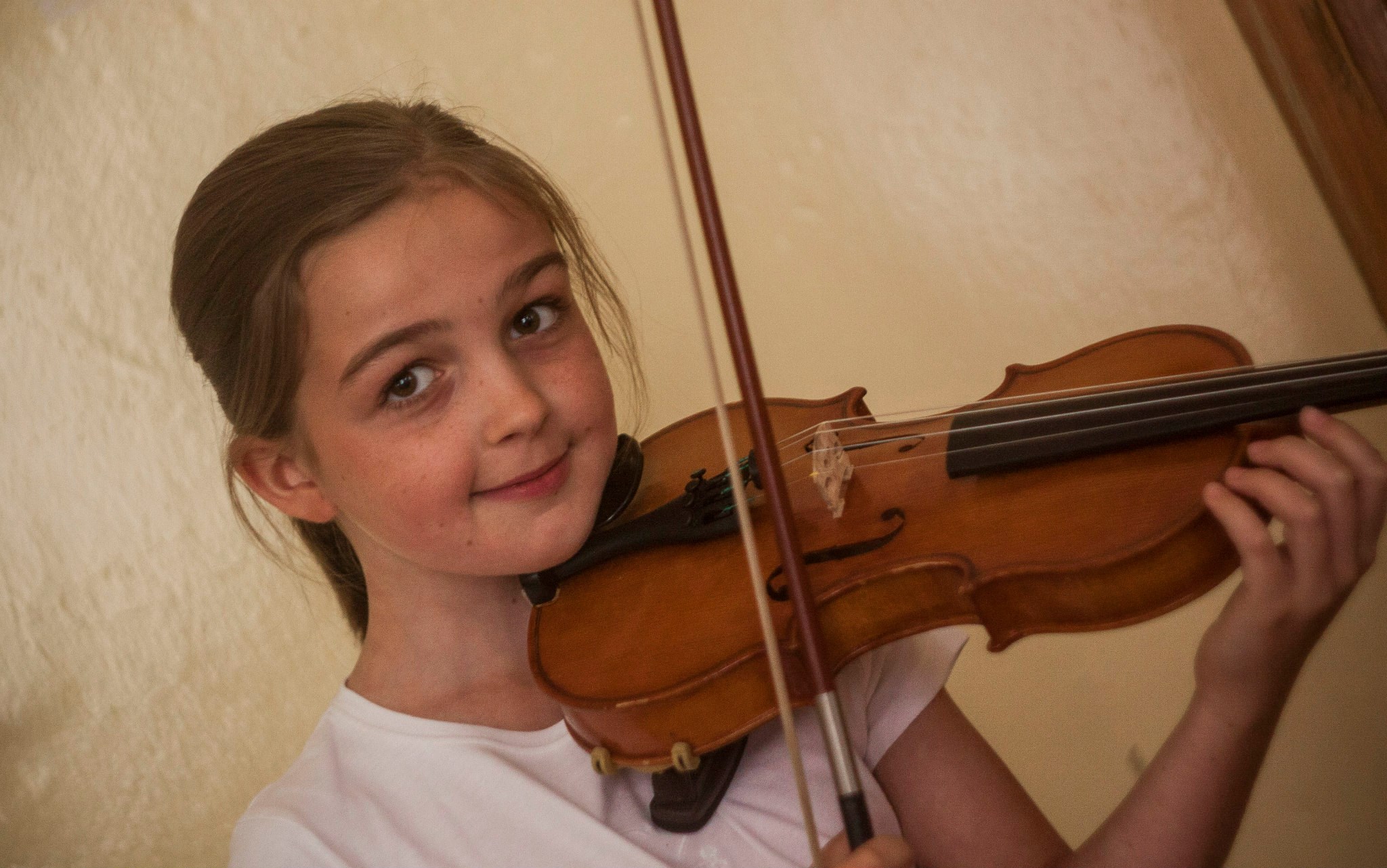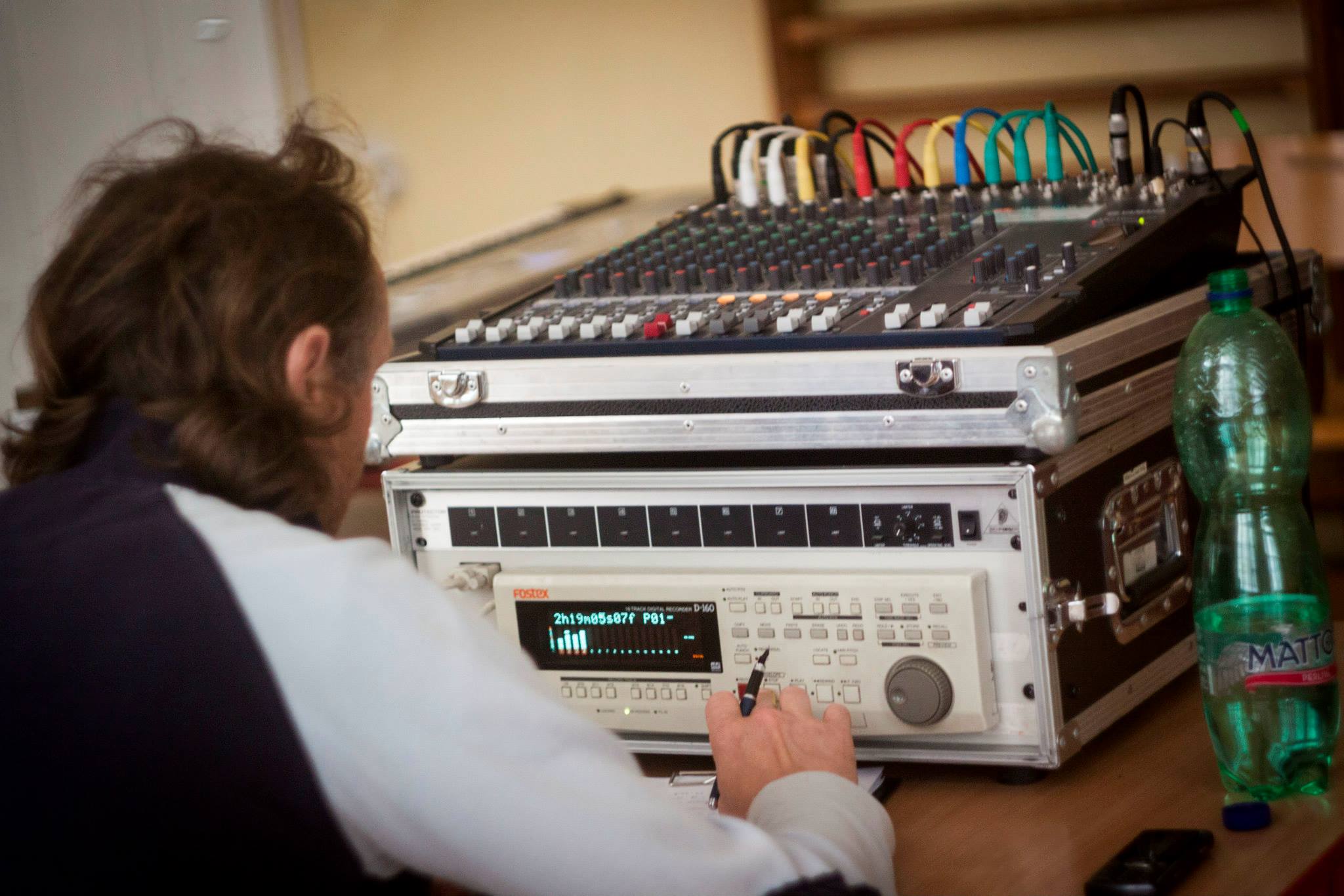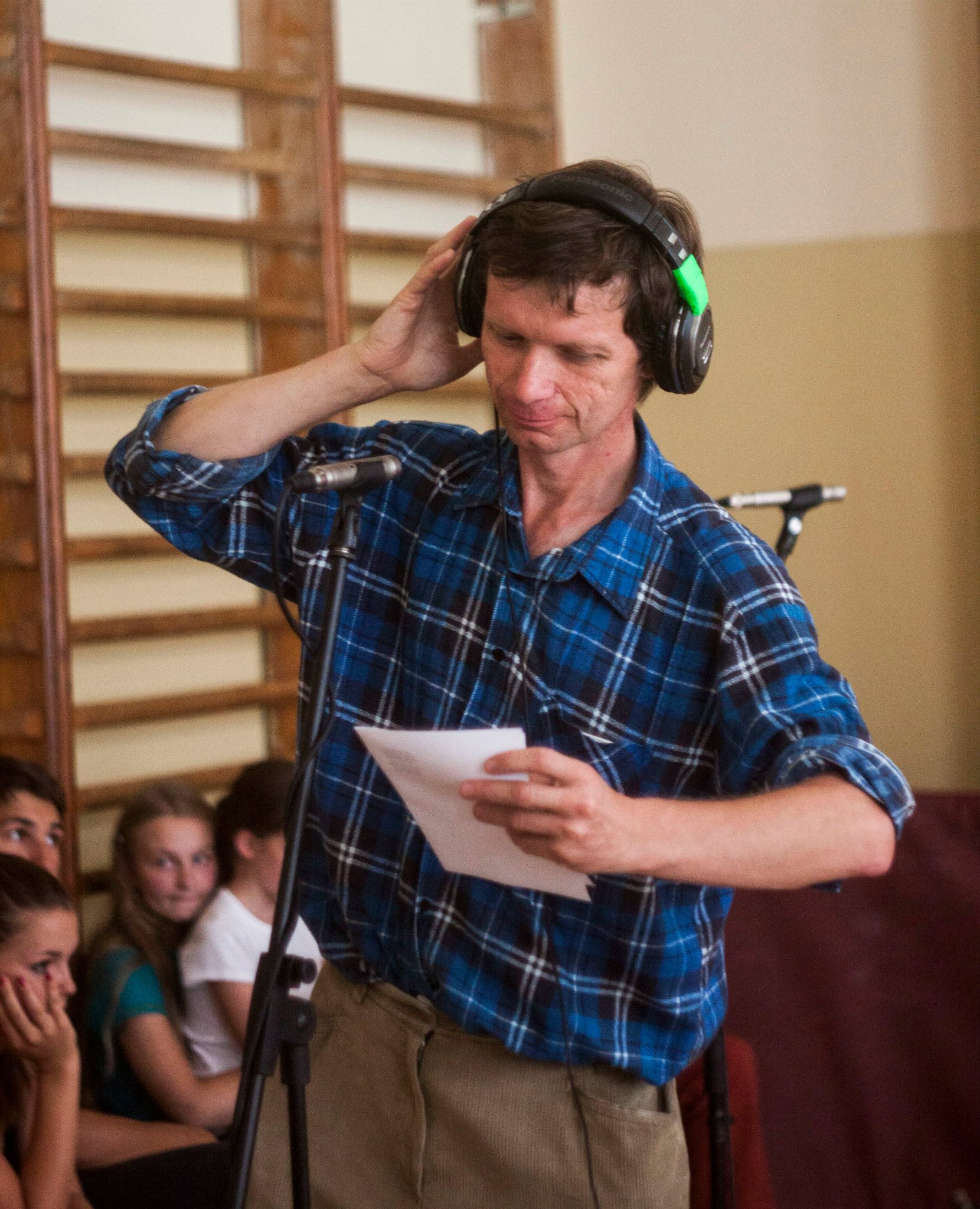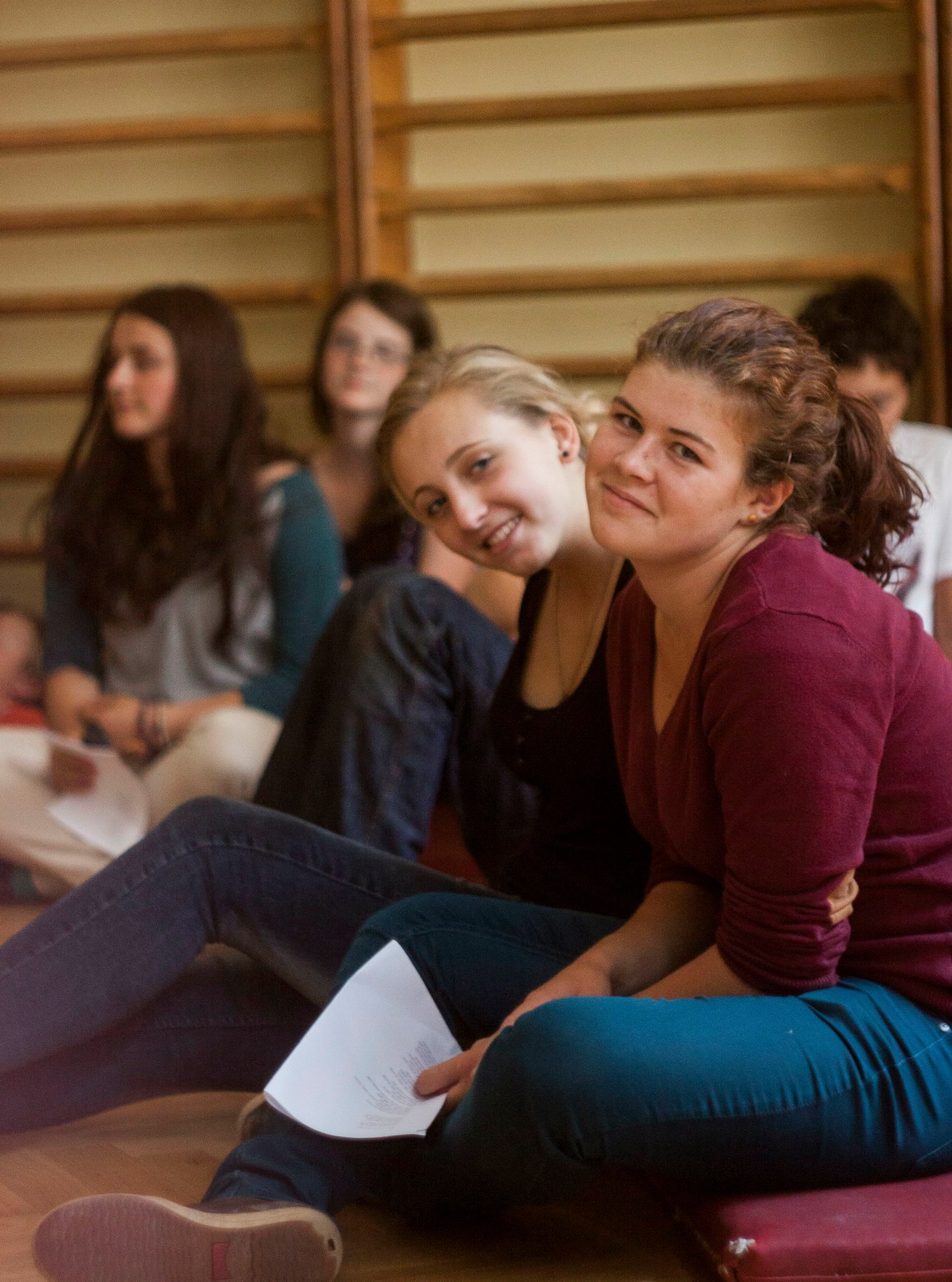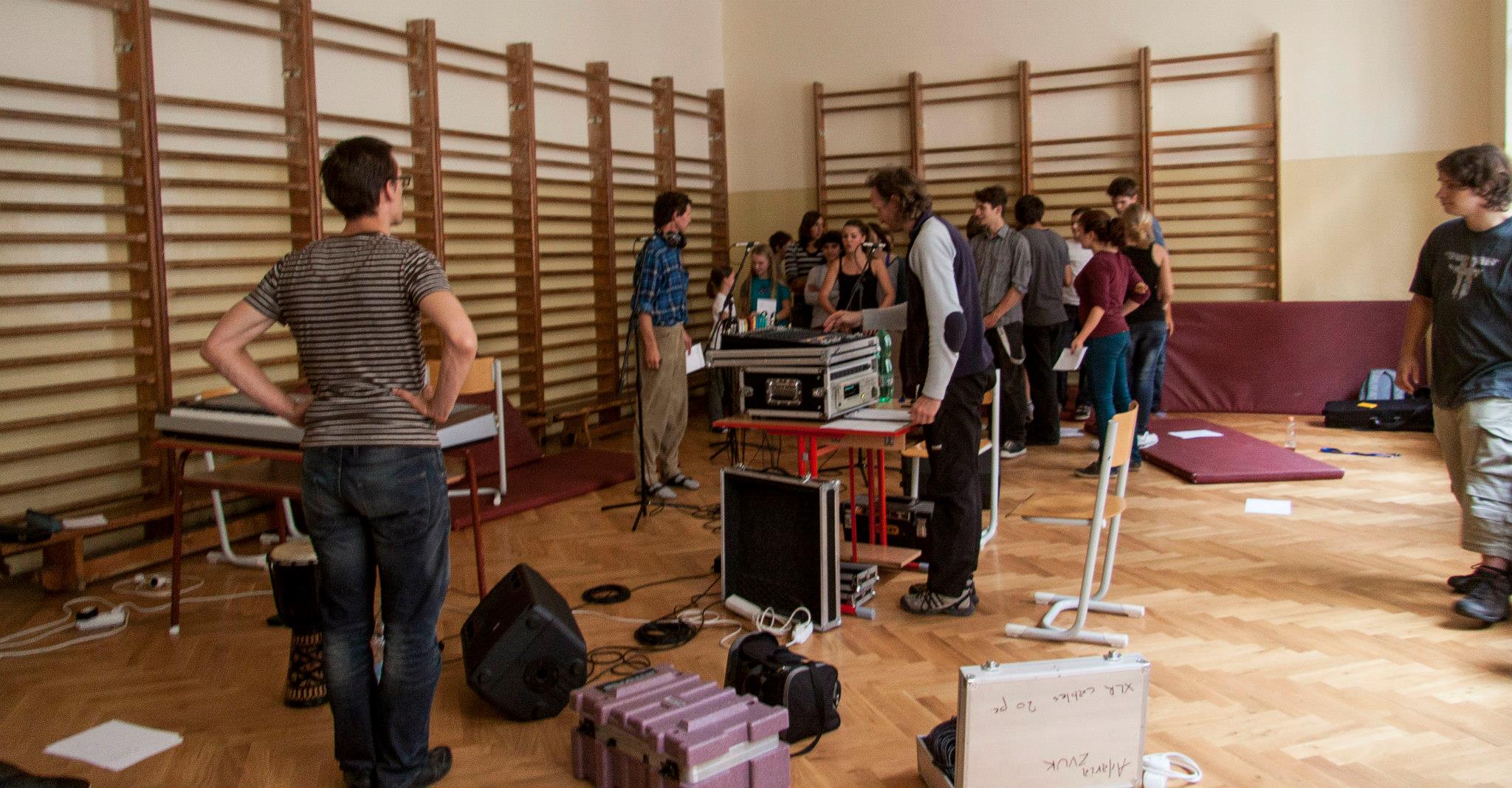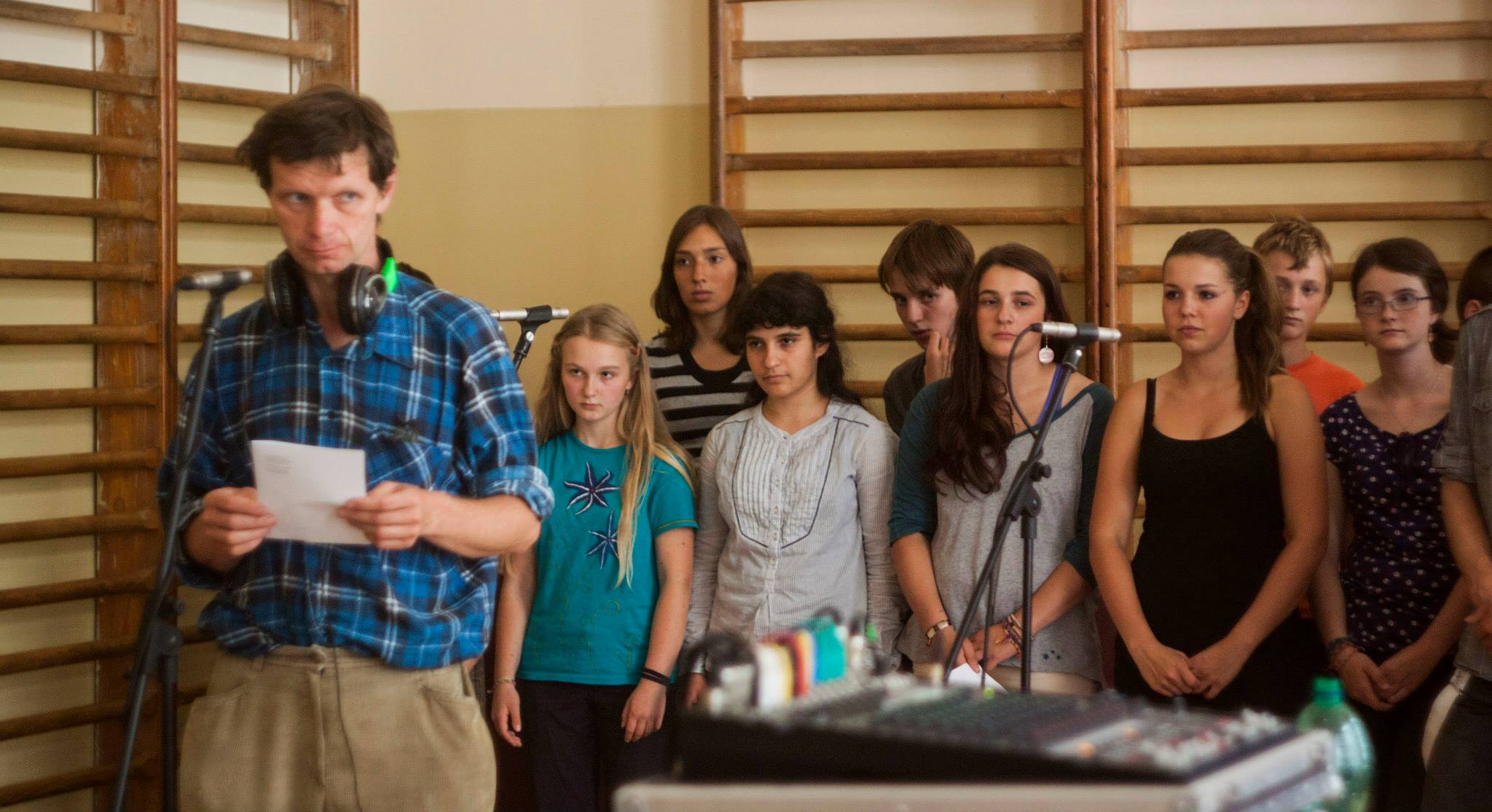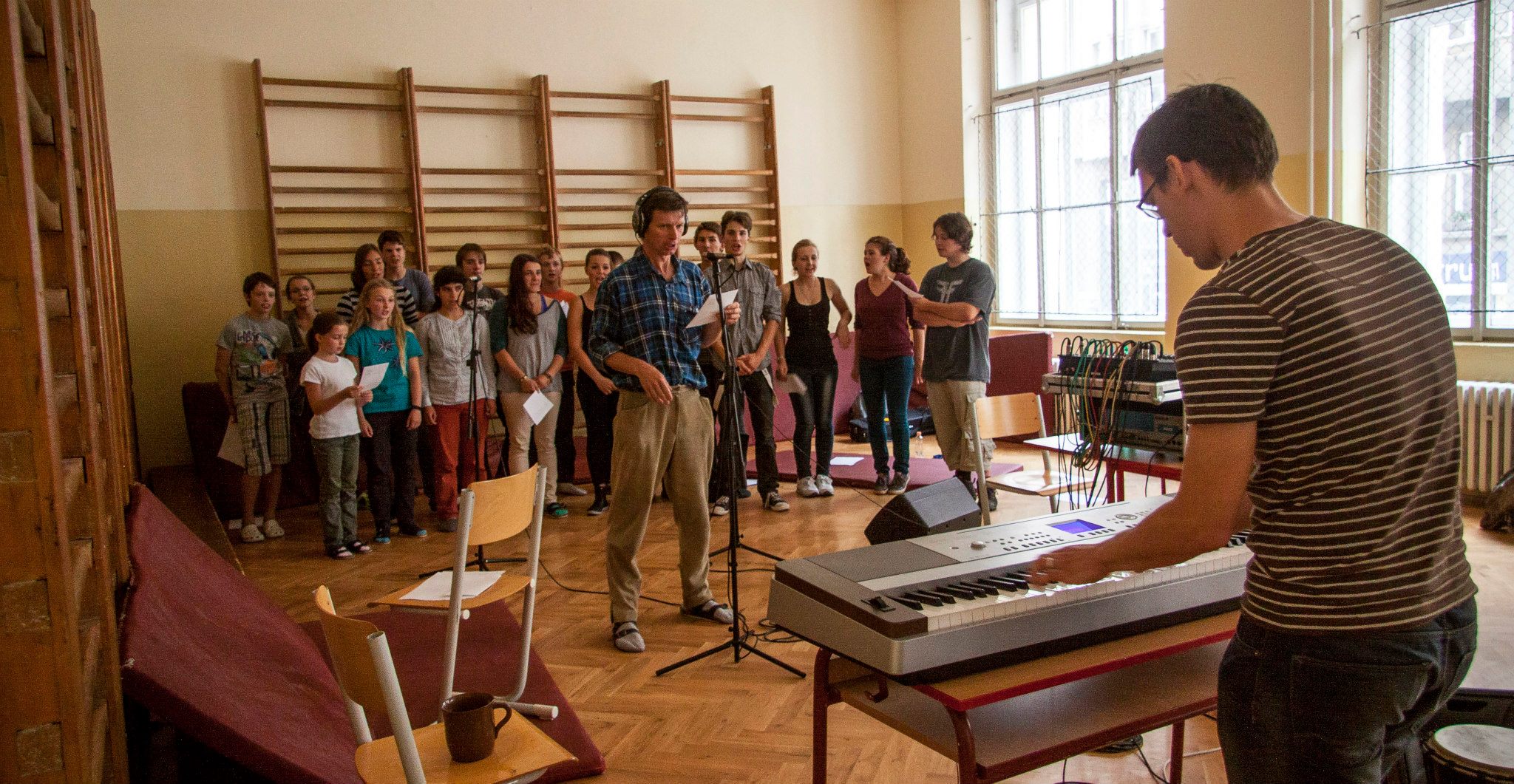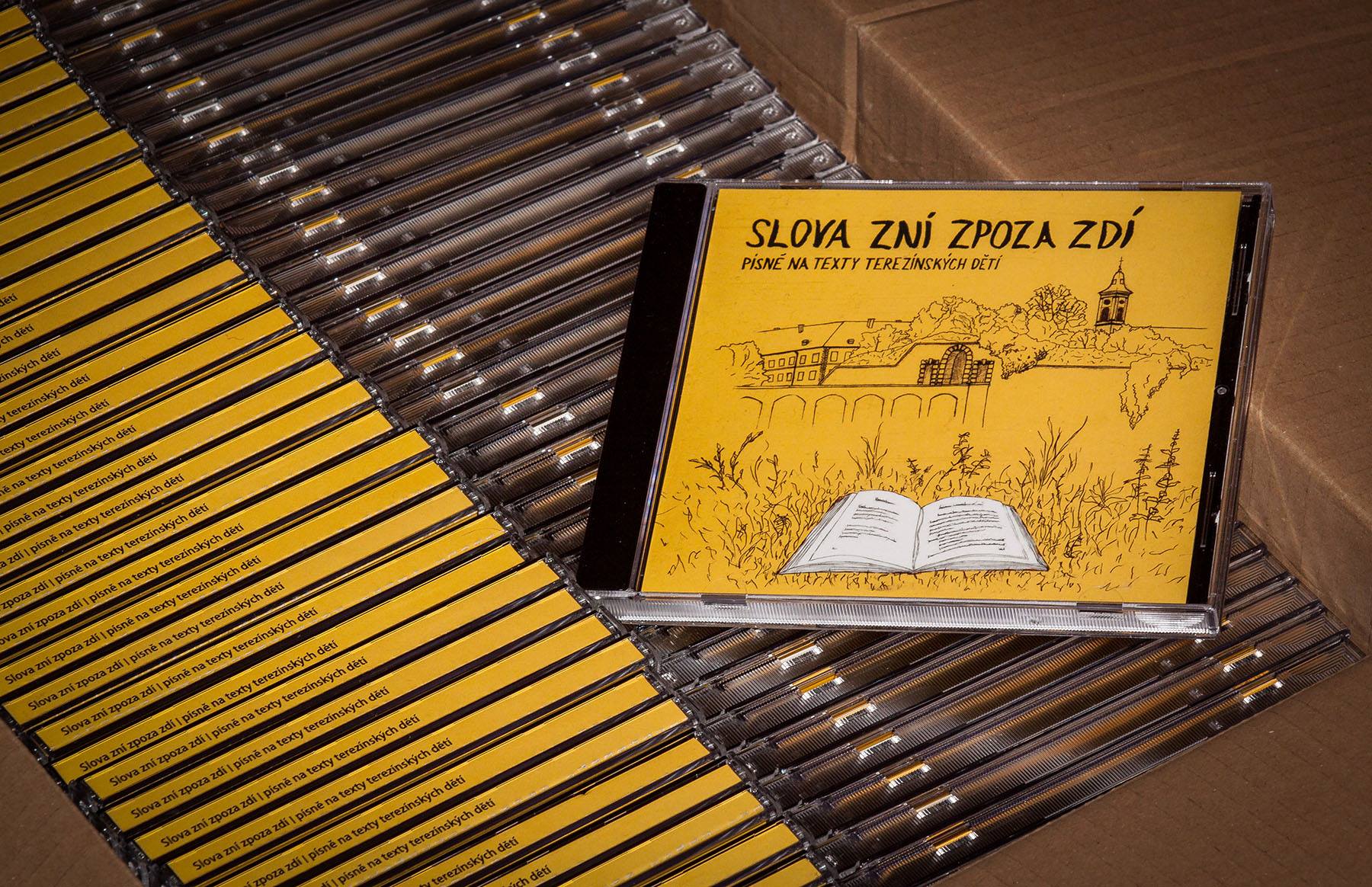CD “Words Echoing from Beyond the Walls”
Over the course of several years dedicated to Terezín-related works, we attempted to set some of the poems to music. Initially, there were sporadic compositions that complemented events dedicated to the life and creativity of Terezín youth. However, as time went on, the number of compositions grew to the point where they warranted their own recording (2013).
The second edition of the CD (2015) was expanded with several compositions created in the last two years for various occasions.
The album “Slova zní zpoza zdí” is our collective tribute to all the courageous individuals who managed to remain true to themselves, loyal to humanity and goodness in Terezín.
The Terezín Legacy Team
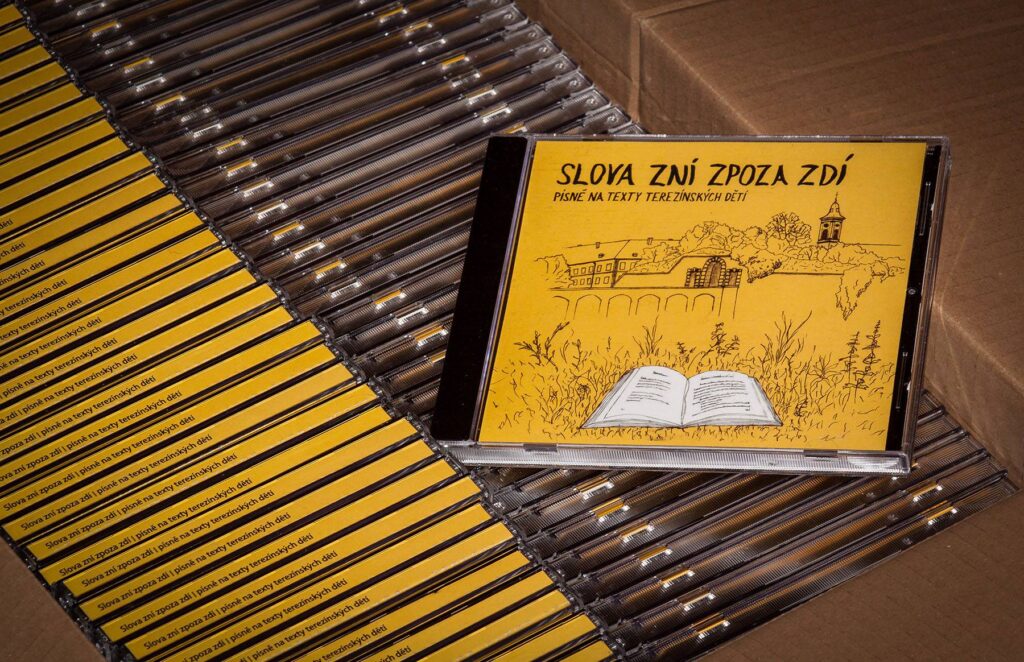
Live acoustic recording of the concert
The recording was made at a concert in Maisel Synagogue in Prague in March 2017.
Performed by students and teachers of Gymnázium Přírodní škola.
Music: Vít Novotný and students of Přírodní škola.
Recording and sound mix: Vojtěch Komárek.
Various teachers and students from our school, with different backgrounds and ages, gradually took on the adventurous task of translating inspirational Terezín texts into the language of music. However, in addition to them, many other students and teachers from Přírodní škola and other schools also contributed to the final versions of the created songs, whether through their singing, playing various instruments, or providing good ideas for instrumentation and melodies.
List of songs
The Anthem of the Republic ŠKID
text: kluci z Domova 1 v terezínském ghettu,
hudba: Karel Hašler (podle písně Hymna svobody)
Today it is clear to all people
text: Petr Ginz
hudba: David Kubec
Blázen
text: Petr Ginz
hudba: Linda Langerová
Polar
text: Petr Ginz
hudba: Timea Pražáková a Linda Langerová
Memory of Prague
text: Petr Ginz
hudba: Timea Pražáková a Linda Langerová
Hrdinná
text: Hanuš Hachenburg,
hudba: František Tichý
S tebou matko
text: Zdeněk Ornest
hudba: David Kubec a Timea Pražáková
Má zem
text: Hanuš Hachenburg
hudba: František Tichý
Srdce
text: Hanuš Hachenburg
hudba: Vít Novotný
Dětem
text: Hanuš Hachenburg
hudba: Vít Novotný
Co se mnou bude?
text: neznámý autor – časopis Rim-rim-rim
hudba: Vít Novotný a žáci Přírodní školy
Sbohem léto
text: Zdeněk Ornest
hudba: Vít Novotný a žáci Lauderových škol
Pohádka
text: Jan Bloch
hudba: Viktor Komárek a Ela Diduniková
Víra v nic
text: Hanuš Hachenburg
hudba: František Tichý
Otazníky s odpovědí
text: Hanuš Hachenburg
hudba: David Kubec
Terezínská hymna (Terezínský marš)
text i hudba: Karel Švenk
In 2009, we, the teachers and students of Prague’s Gymnázium Nature Sxchool, also began to dedicate ourselves to the legacy of the boys and girls who were deported to Terezín. The result of the project is the website www.vedem-terezin.cz, where scans of the magazines Vedem, Kamarád, and Domov were first published in their complete form. Additionally, the Terezínská štafeta (The Terezín Legacy) youth forum was established (www.terezinskastafeta.cz). Over the course of these few years, as we delved into the Terezín texts, we attempted to set some of them to music. Initially, only a few compositions were created to complement events dedicated to the life and creation of the Terezín youth. However, as time passed, we produced so many songs that they warranted their own separate recording.
The adventurous task of translating the inspirational Terezín texts into the language of music was gradually undertaken by teachers and students of our school, each with their own focus and of varying ages. As composers, they tried their hand at this creative work, and on this CD, they present themselves as the authors of the music. Among them are Linda Langerová, a mathematics teacher, František Tichý, a physics and biology teacher, and Vít Novotný, an English and music teacher. Students such as Timea Pražáková (16 years old in 2013) and David Kubec (18 years old) also participated in the composition. In addition to them, numerous other students and teachers from Přírodní škola and other schools contributed to the final versions of the songs, whether through their singing, playing various instruments, or providing insightful ideas for instrumentation and melody.
The album “Slova zní zpoza zdí” (Words Resound from Behind the Walls) is a collective tribute to all the brave individuals who managed to remain true to themselves, devoted to humanity and goodness, in Terezín. The second edition of the CD (2015) was expanded with several songs that were created in the last two years on various occasions.
The medley begins with the Hymn of the ŠKID Republic. It was an imaginary republic established by the boys at Home 1. Within its framework, they formed their own self-government, published a magazine, created a coat of arms, and composed a hymn. The lyrics were written by the boys themselves, but they used the music from a popular song by Karel Hašler at that time.
Most of the other songs were composed by setting to music the poems of three friends from Boy’s Home 1, which were published in the magazine Vedem. The first of them is the aforementioned Petr Ginz, a multi-talented editor-in-chief of Vedem. His strong suit was primarily prose and, above all, excellent reports from the Terezín Ghetto. He was also a very skilled artist and organizer of the boys’ collective life. Even the few surviving poems are worth noting. In their musical form, the composition “Blázen” and “Polární” represent his work, and recently “Vzpomínka na Prahu” (Remembrance of Prague), whose musical version was introduced on the occasion of the release of the biographical book about Petr Ginz titled “The Prince with a Yellow Star.” Among the styles of the other compositions, there is a rap adaptation of Petr’s poem composed before his deportation in Prague, “Dnes je jasno už všem lidem” (Today, it is clear to everyone). With humor that simultaneously sends shivers down the spine, it enumerates all the anti-Jewish measures in the Protectorate.
A year younger, Hanuš Hachenburg published several dozen poems in Vedem (in a comprehensive form, they were later published in the collection “Hned vedle bílá barva mráčků” – “Right Next to It, the White Color of Clouds”). He was a boy who grew up without parents from the age of eight, small in stature, somewhat eccentric, with large radiant eyes, and had a difficult time finding friends. However, his texts still surprise with their depth and linguistic and formal level. The poem “Hrdinná” (Heroic) was written during his stay at the Jewish orphanage in Vinohrady and was inspired by the works of Lermontov. Other texts such as “Otazníky s odpovědí” (Question Marks with Answers), “Dětem” (To Children), “Srdce” (Heart), “Má zem” (My Land), and “Víra v nic” (Faith in Nothing) were created directly in Terezín and reflect the existential search of the legendary “old man with a child’s body” in the conditions of uncertainty and absurd paradoxes associated with life in the ghetto. Hanuš, like Petr, was murdered in the gas chamber of Birkenau.
The last “ŠKID member” whose text will be heard on the recording is Zdeněk Ornest, the brother of the poet Jiří Orten. The musical version of his poem “Sbohem léto” (Farewell, Summer) was created as part of a project in the Lauder schools in Prague, coincidentally in the same building where Zdeněk and Hanuš stayed before their deportation to Terezín. The music was co-authored by twelve-year-old students from the first grade. Another poem by Zdeněk, “S tebou matko” (With You, Mother), was also published in the Vedem magazine and interestingly reflects the longing of the interned boys for a “journey to the sun” to a land where the “flags of freedom fly.” Zdeněk himself survived the war and became a well-known actor.
The children from the lambda class at Přírodní škola, both boys and girls, also contributed to the music for the poem “Co se mnou bude?” (What Will Happen to Me?). This text was published in the Rim-rim-rim magazine, which was issued by the boys at the Nešarim home in the L 417 building in the Terezín ghetto in the first half of 1944. The song was originally created as an accompaniment to the film “Klub pěti terciánů” (The Club of the Five Tercians), which was made by the students of Přírodní škola based on a serialized story published in Rim-rim-rim. Today, it is among the most popular songs of the Terezínská štafeta project and has become the unofficial anthem of the 2nd year of the “Převezměte terezínskou štafetu” competition, dedicated to this home and magazine.
The finalists of this competition are also the composers of the music for the second poem from the Rim-rim-rim magazine, “Pohádka” (Fairytale) by Jan Bloch. While the author of the text was thirteen years old, the current composers and performers are two years younger, representing the youngest generation to be inspired by the messages of their peers from the Terezín ghetto.
The collection of songs concludes with the composition “Terezínská hymna” (Terezín Hymn), which pays tribute to the older generation of creators. The music and lyrics were written by Karel Švenk, a renowned creator of cabarets in the 1940s. It was first performed in the cabaret program “Ať žije život” (Long Live Life) in Terezín and gradually became one of the most beloved songs among the involuntary residents of the ghetto. Although the optimistic ending, “and we will laugh on the ruins of the ghetto,” did not find fulfillment for the majority of Jews during the war, after many decades it can remind us that every evil, darkness, and lack of freedom will eventually come to an end.
We would like to thank everyone who helped us with the creation of the CD and the Terezín Relay project. Especially to the musical director Vašek Vobořil and Pavel Jindrák, Filip Mašek, Matouš Bičák, the Terezín Initiative, the Lauder Schools, the management of ZŠ Strossmayerovo náměstí, the Jewish Museum Prague, the Terezín Memorial, and all the participating musicians.
“The seed of creative thought will never perish…” wrote fifteen-year-old Petr Ginz behind the walls of the Terezín ghetto. Like thousands of other boys and girls condemned to isolation and waiting for transport into the unknown, he did not sit idly by. Together with his friends from Boys’ Home 1 in Terezín, he wrote the magazine Vedem, secretly learning and creating. Although his life ended shortly thereafter in the gas chamber, his message endures to this day and continues to inspire generation after generation, even after seventy years.
The fortress town of Terezín near Litoměřice was chosen by the Nazis and incorporated into their plan for the “Final Solution to the Jewish Question” as a ghetto where citizens from Germany and occupied countries who were classified as Jews or Jewish hybrids under the Nuremberg Laws would be gathered. In the town, which had a population of around 5,000 before the war, more than ten times that number were moved in a short period of time. The city was overcrowded, and the Jewish Council of Elders, entrusted with the administration of the city, struggled to provide food, clothing, medical care, and accommodation for the incoming transports. Unfortunately, Terezín with its hunger, filth, parasites, diseases, and lack of privacy was not the final destination for the Jews. Most of them were eventually transported to extermination camps and murdered there.
However, special attention was paid to children and youth. Older boys and girls were accommodated in special homes called “heims.” Here, they not only had slightly better living conditions and a bit more food, but they also had educators and teachers dedicated to their care. As a result, distinct communities with their own traditions, focus, and cultural and sporting life emerged in each home. The most well-known were the boys’ homes located in the building of the former school, designated during the war as Object L 417. The tangible evidence of the life and creativity of those twelve to sixteen-year-old boys is primarily found in the magazines they secretly published in each home. The most famous of these is the magazine Vedem, published by the boys in Boys’ Home 1 clandestinely from the autumn of 1942 to the spring of 1944. It contains an immense amount of reflections, reports, stories, and poems. But it was not alone – other magazines include Rim-rim-rim, Kamarád, Noviny, Domov, or Bonako, whose authors were girls from the home in L 410.


